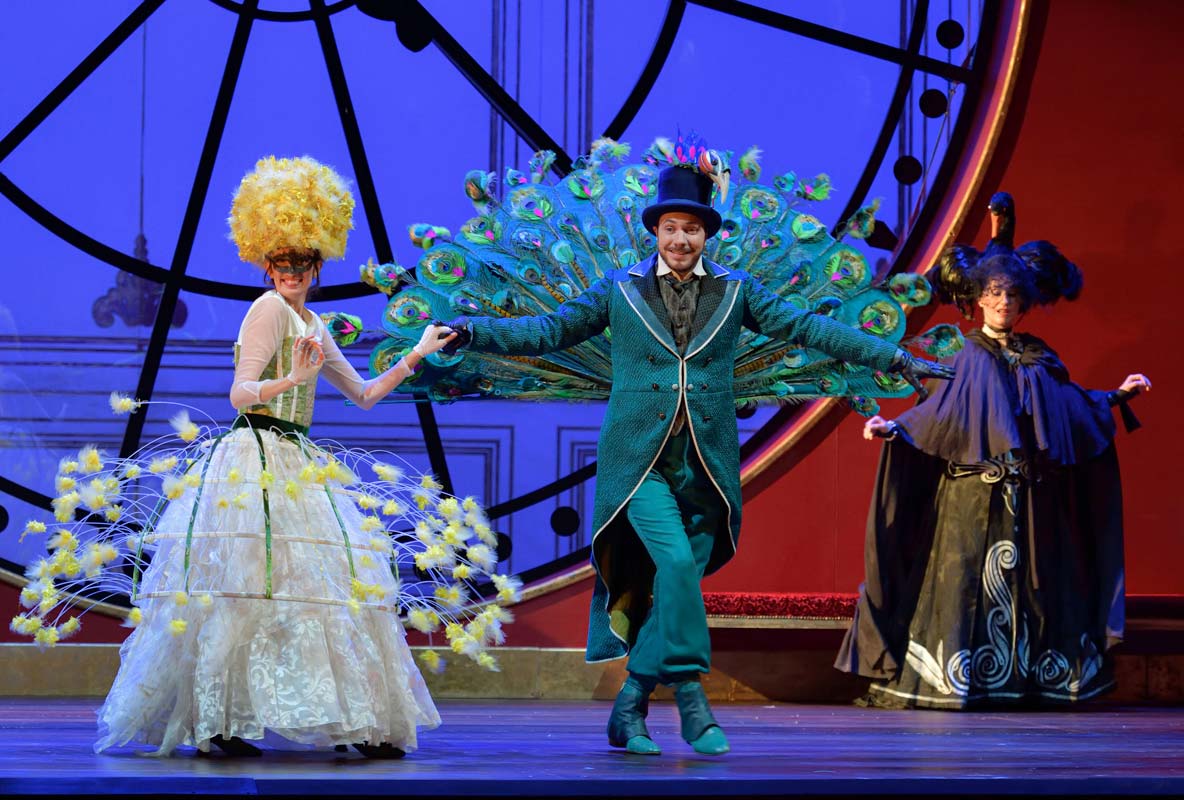
Credit: Opéra-Comique © Stefan Brion
The Black Domino fills the start of the school year at the Opéra-Comique with color
22th September 2024 - Ôlyrix, Juan Barrios
The Opéra Comique de Paris opens its new season with panache thanks to Daniel-François-Esprit Auber’s Domino Noir on a libretto by Eugène Scribe, in the dazzling production staged by Valérie Lesort and Christian Hecq, under the precise musical direction of Louis Langrée.
Under the baton of the Director of the venue, Louis Langrée, the Overture is immediately striking for its efficient fluidity and its careful dynamics. Enough to immediately plunge the audience into a party atmosphere, with the appearance of the characters disguised as “dominoes”, provoking laughter and lightness (a play on words because the Domino in the story is a coat, a carnival disguise that hides the mysterious Angèle de Olivarès, who then finds herself sought after like a Cinderella).
Valérie Lesort and Christian Hecq offer an inventive staging (taken up by Laurent Delvert) where the sets come to life in an unexpected way. Laurent Peduzzi’s scenography combines vitality and charm. A gigantic clock opens the ball in the first act (symbolizing the time that presses Angela’s decisions). Count Juliano’s house with an imposing Christmas tree for Act II depicts opulence and festivity, while a sumptuous convent with animated statues for Act III offers a setting that is both mystical and theatrical. Vanessa Sannino’s costumes impress with their diversity and creativity: light ball gowns floating like bubbles in the air, a horse costume or nuns’ habits with emblematic headdresses (to the point that they are even taken up by the reception staff).
The puppets, made by Carole Allemand, add a whimsical dimension, perfectly integrated into the visual style of the whole. From pigs that wake up to tables that dance, each element is designed to surprise and entertain.
Christian Pinaud enhances each scene with his dynamically adjusted lights, playing on the contrasts between the ball party and the angelic atmosphere of the convent. Glyslein Lefever offers fluid and surprising choreographies, such as these nuns flying in the air.
Anne-Catherine Gillet embodies the role of Angèle de Olivarès. Her warm voice and very agile technique adapt to each situation, to the point of sweetness captivating the audience with her angelic accent but also in an energetic spirit of rebellion.
Cyrille Dubois brings emotional depth to the role of his suitor Horace de Massarena. Her dynamic voice and comic stage performance lead to a touching fragility, offering a palette of nuanced emotions.
Victoire Bunel, as Brigitte de San Lucar, combines a warm timbre and precise vocal placement, without neglecting the tragic and passionate dimension of this other novice nun.
Léo Vermot-Desroches, in the role of Count Juliano, demonstrates great mastery. His tenor voice, with a warm timbre and balanced power, harmonizes fully with the orchestra, reinforcing the character’s character. His dynamic stage performance makes him a great ally of Horace.
Marie Lenormand, her governess Jacinthe, stands out with her extremely comical and controlled stage performance, like her singing with clear and no less powerful, communicative diction.
Jacinthe’s lover, Gil Perez, is accurately played by Jean-Fernand Setti, even in his drunkenness with a crushing voice and a humorous stage presence.
Sylvia Bergé, a member of the Comédie-Française, effectively plays Ursule (the jealous sister aspiring to become an abbess) with a dark and serious voice made of reliefs but without caricature.
Laurent Montel (Pensionnaire at the Comédie-Française) is no less effective and determined as Lord Elfort (attache to the English embassy), without forgetting Isabelle Jacques (La Tourière) with a classic placement, and Laurent David (member of the Éléments), with a brief but warm declamation in the role of Melchior.
Louis Langrée maintains his sense of timing and finesse throughout the show, with balance and clarity. The alliance of the Orchestre de chambre de Paris with the soloists and the choir is marked by harmony. This choir, Les Éléments (directed by Joël Suhubiette) provides effective support, adding vocal textures to the ensemble.
The audience did not hide its enthusiasm, warmly greeting each performer. At the end of the evening, Louis Langrée was decorated with the insignia of Commander in the Order of Arts and Letters by François Henrot (one of the five “Ambassadors of the Opéra-Comique”).